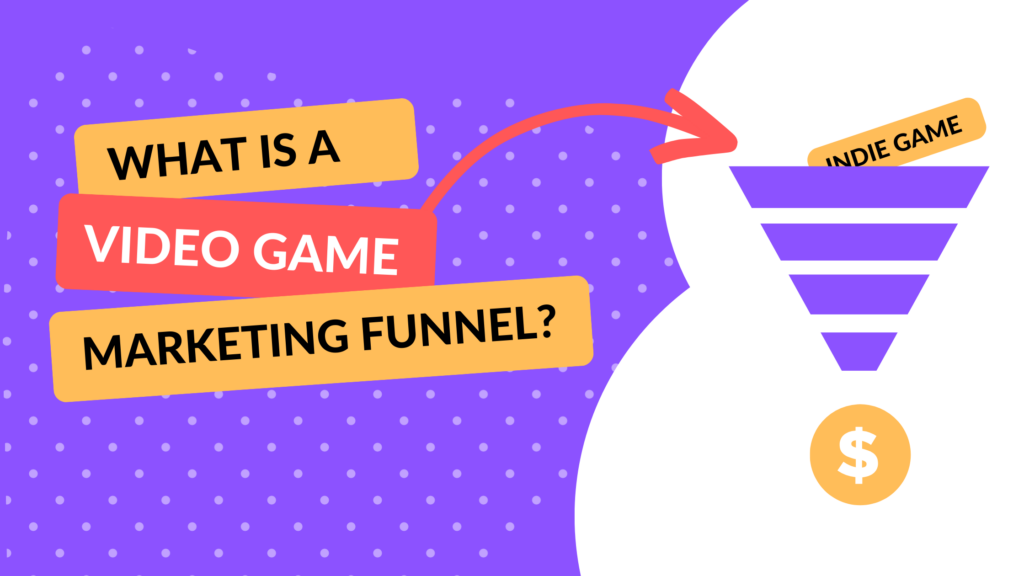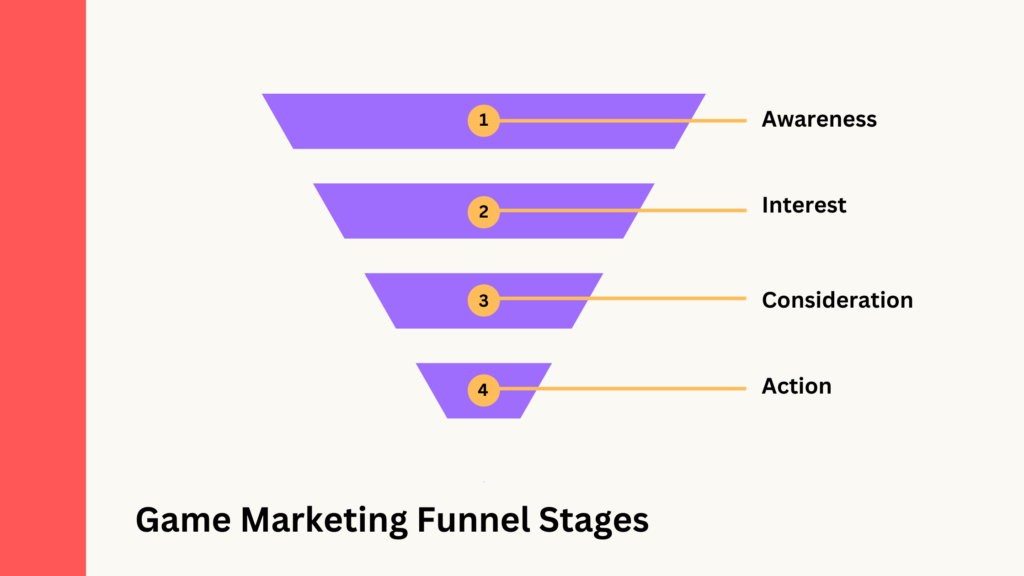
How do you find people who don’t yet know about your indie game but would be interested in playing it? Well, that is where the marketing funnel comes in. What is a video game marketing funnel?
A video game marketing funnel is a framework that represents the journey a player takes from awareness of a video game to purchase and beyond. It‘s a tool used by video game marketers to understand how players discover, research, and ultimately decide to purchase a video game. The video game marketing funnel is typically divided into four or five stages: awareness, interest, consideration, action, and (sometimes) loyalty.
If you’re wondering why this framework is called a funnel, it’s because the number of people at each stage of the funnel decreases at each stage – like how a funnel is larger at the top than the bottom. Let’s take a closer look at the funnel.
The Journey of a Player: The Stages of the Video Game Marketing Funnel

When you search online for marketing funnels, there are numerous different versions of the framework. Generally, the journey of a player through the marketing funnel can be divided into four key stages, each with its own set of marketing tactics and strategies. The stages are awareness, interest, consideration and action. Let’s break this down.
Build Awareness
At the top of the funnel, players become aware of your game’s existence. Awareness can be achieved through marketing efforts such as social media campaigns, advertising, and PR. In short, this stage is about creating attention-grabbing marketing content for your game and displaying it where your target audience can find it.
This first stage is sometimes referred to as TOFU, Top of Funnel. This is where people will have no existing knowledge of your game. This stage of building awareness is sometimes referred to as building brand awareness, so our funnel could be considered a game brand funnel.
Spark Interest
Once players have seen information about your game, some of them will want to learn more about it. This is where your trailer comes into play; gamers want to see the gameplay and features of your game. The goal at this stage in the funnel is to convince players that the game is worth their time and money.
This first stage is sometimes referred to as MOFU, Middle of Funnel. This is the stage where people have some knowledge of your game and want more juicy details.
Consideration: Help Players Make A Decision
At the consideration stage, the player is evaluating whether to purchase or download your game. Factors that affect gamers’ purchasing decisions include price, reviews, and the player’s overall level of interest in the game. You can make the decision process easier by offering a discount, encouraging reviews, and creating the most interesting video game trailer and screenshots.
Drive Action
The action stage is when the player takes the desired action, such as purchasing or downloading your game. The key consideration here is to make taking action easy. If you’re selling your game on a platform like Steam, it will take care of the purchasing process for you.
Encourage Loyalty (Sometimes)
Sometimes, the loyalty stage is included in the marketing funnel. At this stage, the player becomes a long-term player and continues to engage with the game on an ongoing basis. They may continue to return to the game and potentially even recommend it to others. The reason this stage is only sometimes included is that it’s mostly relevant for online games where a community is needed or where there will be ongoing content drops, such as DLC. If players love your game, you will see loyalty organically.
How to Create a Successful Game Marketing Funnel

Video game marketing is a harsh industry, and it’s hard to get your game noticed. Many developers spend lots of money on ads, only to see that their money is wasted. This is because they don’t know how to create a successful game marketing funnel that converts leads into paying customers. Here are some tips on how to install a video game marketing funnel.
Know Your Audience
You must understand who your target audience is, where they are and how old they are. If you don’t know this information, it will be difficult for you to find them later when they need your product or service. In addition, if you do not know what kind of content they like, it will be hard for them to convert into customers later on.
Create a Website and Landing Pages for Each Stage of Your Funnel
You should create a website for each stage of your funnel so that there is one place where people can go if they want more information about what you offer or want to buy from you directly. These websites should contain information about each stage of your funnel and any freebies or bonuses that come with purchasing from that stage of the funnel. Also, ensure that all links are clickable and easy to read so visitors can quickly get where they need to go without having trouble finding anything that interests them on your website.
Create Content That Appeals To Your Audience
To get more people interested in your game, you must create content that appeals to them. Using audience personas to craft content with them in mind is key to achieving this. Additionally, engaging with your audience through social media, discord servers, and forums is another great strategy for getting feedback and building a community around your game.
Focus on the Customer Journey
Before you even think about building out your funnel, it’s essential to understand where each step will fit in the customer journey. This means you must identify what each phase is designed to do and what value it offers customers along the way. For example, suppose you’re selling an educational game for children. In that case, you may want to include a registration form at the top of your page so that parents can sign up for updates on new products and special offers from your company as well as subscribe to an email list so that they can receive updates directly from you at any time in the future when they may need help with learning or improving their skills related to playing video games.
Wrapping Up
A marketing funnel is a powerful tool when planning your indie games marketing. Considering the players’ customer journey and minimising friction to purchase your game will work to ensure a successful game launch.
